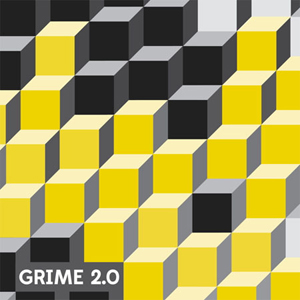Various Artists Grime 2.0
In truth, grime must be beyond its “version 2.0” by now. During the decade-plus gulf […]

In truth, grime must be beyond its “version 2.0” by now. During the decade-plus gulf between the pirate-radio and SoundCloud eras, dance music has undergone all sorts of developments, yet grime has kept its sound as looming and vertiginous as the Brutalist tower blocks casting shadows over the London neighborhoods which spawned it. Still, it has always made room for growth and permutation—not just inside the East End core, but also throughout the UK, Europe, Australia, and North America. Semantics aside, Big Dada’s Grime 2.0 compilation—assembled by Joe Muggs, a longtime advocate for grime’s continued relevance and vitality—is a valiant and successful effort to reveal just how far the style has come, even as it maintains the genre’s own distinct characteristics of wild-out basslines, anthemic hooks, and transatlantic hip-hop signifiers reconstructed for its own purposes.
Brief pop detours by the likes of Dizzee Rascal and Wiley notwithstanding, grime’s notions of journeyman experimentation and insulated DIY ethics have kept it largely free of hype frenzies and major-label meddling. So when an artist tweaks the formula, it typically comes from a place of personal idiosyncrasy, or even a happy accident, rather than some quid-chasing compromise. That could be why the uninitiated might have a tricky time determining who the traditionalists and who the inconoclasts are on this collection—especially when they’re often one and the same.
Aforementioned elder statesman Wiley isn’t just one of grime’s foundational artists, he’s also one of its most restless tinkerers; if his “Logic Pro” is warmer and less in-your-face than the icy, lo-fi-digital eskibeat sides that made his name, it still mantains the imprint of a rhythm that’s directly traceable to grime’s earliest garage variations. Virus Syndicate‘s MRK1, one of a handful of grime producers who made a respectably successful crossover to dubstep in the mid ’00s, contributes the nuanceless thrills of “Smash It Up Hard,” a tune which incorporates everything from Brick Squad synth-orchestration to Prodigy breaks circa ’95. And Footsie, the Newham Generals cornerstone and underrated hero of the UK dance scene, kicks off Grime 2.0 with an excitingly brief slab of woofer-destroying, rave-synth filth. Called “Oh My Gosh,” it’s as close as this comp gets to making grime sound like an arena-filling proposition while still staying true to its roots.
There is a loose dichotomy between the aggressive density and stripped-down immediacy put forth on Grime 2.0, but neither style feels at odds with the other or out of place in the bigger scheme of things. The heaviest cuts—i.e. “Oh My Gosh,” Chaos & Order‘s break-driven dubstep feint “Logan’s Mind,” and Juzlo‘s wobble monster “Nail Thrower”—have the same underlying spark of breathless momentum which drives the sparer nods to the classic ’03 sound. “Vinyls VIP,” the juxtaposition of loping synth-horns and liquid-metal percussion put forth by Preditah, does a lot with its uncluttered spaciousness, as does Chimpo‘s cavernous piledriver of a riddim, “Codeine and Dragon Stout,” and the warped G-funk chords of Mr. Mitch‘s ODB-invoking “Viking”. Still, there are pockets inside variations inside niches which offer plenty of opportunities to ambush expectations. Even J Beatz‘s “Shotta Krew” banger, a cut that could make for a pretty straightforward Lord of the Mics backdrop, subtely switches up its rhythmic tricks in slippery ways.
Grime 2.0 is better taken as a snapshot of individual highlights than as a waypoint for where the genre itself is headed. In fact, it seems to reveal that the scene may be at its strongest when its producers are headed in as many directions as possible. Recent breakthrough artist Darq E Freaker, who went from the bludgeoning devastation of Tempa T‘s “Next Hype” to the manic brilliance of Danny Brown-teamup “Blueberry (Pills & Cocaine),” makes his mark here with the arpeggiated gleam of post-trap headrush “Trojan.” Royal-T further explores the bracing maximalism of his debut LP for Rinse with “Space Cowboy VIP,” hijacking house energy and tweaked trance buildups to use for his own ends. Shy One‘s “927” defies expectations by delivering one of the most rhythmically intricate and atmospheric UK funky-inflected cuts on the 35-track collection. Meanwhile, the international artists who soaked up grime’s influence from thousands of miles away—such as Philadelphia’s Starkey (“Tunnel”), Brooklyn’s Matt Shadetek (“Battery Charge”), and Tokyo’s Prettybwoy (“Kissin U”)—have gestated their work in their own isolated, underground circles, mastering genre-bending ways of approaching grime’s 2-step pedigree in the process. As a whole, Grime 2.0 works as both an introduction and a re-introduction to a sound that’s still without an official expiration date—and won’t likely get one anytime soon.

